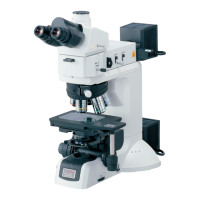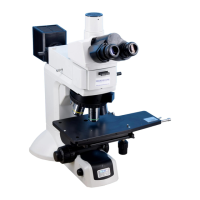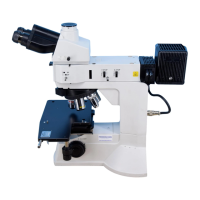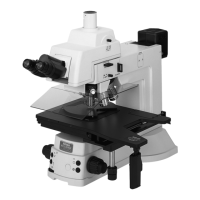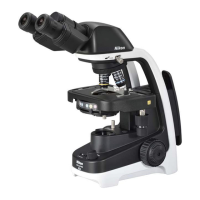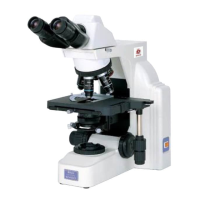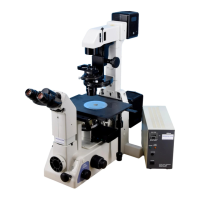17
II. Microscopy
3
Conoscopic Observation
This section describes the conoscopic observation procedure. This is the characteristic observation method of
polarizing microscopes. In this method, the specimen is observed with the polarizer, the analyzer, and the
Bertrand lens placed in the optical path.
The specimen can be observed from various angles with diascopic light in the form of a single image.
However, the shape of the specimen itself is not visible with this observation. You can distinguish the property
of the specimen between uniaxial and biaxial and can observe the optical axial angle and optical characteristics
of the specimen.
1
Perform the orthoscopic observation. (Refer to Page 16, “2 Orthoscopic Observation.”)
2
Rotate the Bertrand lens turret on the
polarizing intermediate tube to the “B”
position to locate the Bertrand lens into
the optical path.
See Page 39.
3
Focus and center the Bertrand lens.
See Page 39.
4
Perform the conoscopic microscopy.
• The P-CL 1/4 λ & tint plate is not used in this
microscopy. Move it to the vacant position.
• Select an objective having a large numerical
aperture (high magnification: normally 40x or
higher).
• The condenser aperture diaphragm should be
adjusted so that its image circumscribes the
conoscopic view field or should be fully opened.
• The field diaphragm should be adjusted so that
its image circumscribes the conoscopic view
field.
• The top lens of the P swing-out condenser must
be placed in the optical path.
See Page 29.
The table below shows the settings for the orthoscopic microscopy and the conoscopic microscopy.
0
BIN
O
PHOTO
P
H
OTO
B
IN
O
&
Set to the
“B” position.
2
N
D
8
NC
B
F.S
.
0
.
4
0
.
2
0
.
8
0.
6
JA
P
AN
A
chr
0
.
9
0
0
BINO
PHOTO
PH
O
T
O
B
INO &
Focus the
Bertrand lens.
Center the
Bertrand lens using
the two screws.
3
3
Orthoscopic observation
Observation for light extinction or interference color
of the specimen to detect the vibration direction of
the light and the property of the double refraction.
OUT (“0” position)
Conoscopic observation
Observation for the property between uniaxial
and biaxial and observation for the optical
axial angle and optical characteristics.
IN (“B” position)
IN
Circumscribe the conoscopic view field
(or fully open)
Circumscribe the conoscopic view field
10x or higher
4x or lower
10x or higher
4x or lower
10x or higher
4x or lower
IN
OUT
70% to 80% of the numerical
aperture of the objective
Fully open
Circumscribe the view field
Fully open
Observation purpose
Bertrand lens
Top lens of the P
swing-out condenser
Condenser aperture
diaphragm
Field diaphragm
